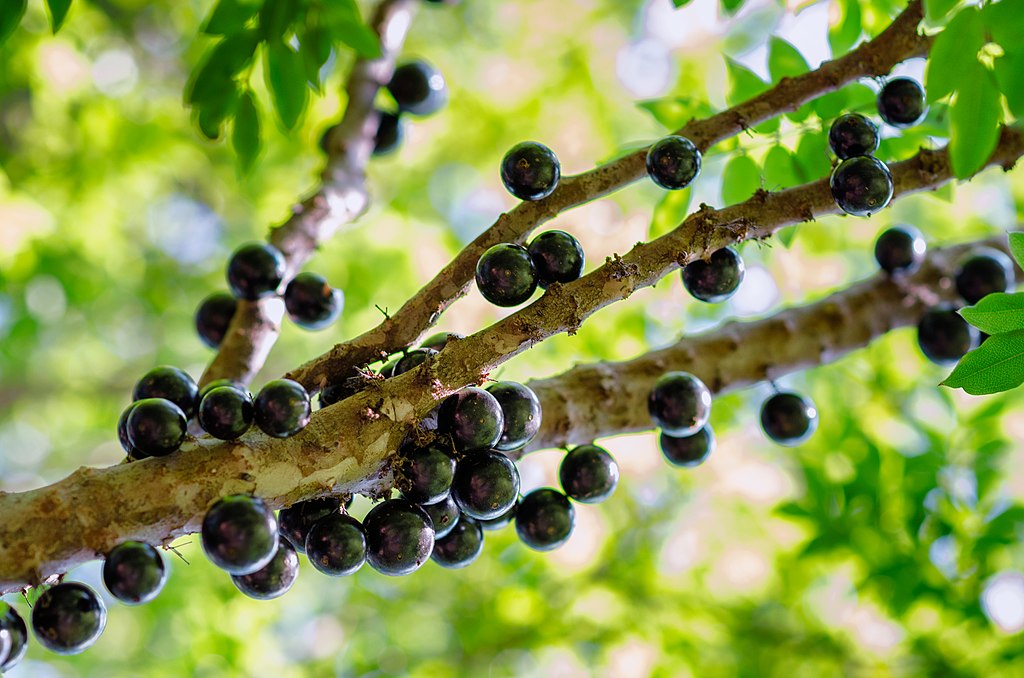

The study focused on simultaneous extraction and purification of anthocyanin derived from jabuticaba peel, a lignocellulosic residue (image: Bruno.karklis/Wikimedia Commons)
The process, developed by Brazilian and Spanish scientists, obtains anthocyanin from fruit processing waste with a higher yield than the usual method.
The process, developed by Brazilian and Spanish scientists, obtains anthocyanin from fruit processing waste with a higher yield than the usual method.

The study focused on simultaneous extraction and purification of anthocyanin derived from jabuticaba peel, a lignocellulosic residue (image: Bruno.karklis/Wikimedia Commons)
By Ricardo Muniz | Agência FAPESP – Scientists at the State University of Campinas (UNICAMP) in Brazil and the University of Cadiz (UCA) in Spain have successfully deployed a novel method of extracting high-value-added chemical compounds from the peel of jabuticaba (Plinia cauliflora). The method, which simplifies the process and enhances its efficiency, is described in an article published in Journal of Food Composition and Analysis.
The aim was to optimize extraction of anthocyanin, a potent antioxidant found in strawberries, blackberries and raspberries as well as jabuticabas, among other sources. It has anti-inflammatory effects and is also a natural colorant responsible for the shades of red, blue and purple seen in many flowers, fruits, leaves, stalks and roots.
The study focused on simultaneous extraction and purification of anthocyanin derived from jabuticaba peel, a lignocellulosic residue. “The investigation meticulously adjusted the extraction parameters in order to achieve optimal results,” says Tânia Forster-Carneiro, a professor at UNICAMP’s School of Food Engineering (FEA). She has worked there since 2013, specializing in bioengineering and biotechnology research.
After optimizing extraction, the researchers developed a purification technique using biosorbent material derived from the residue. Sorbents take up materials by absorption or adsorption. Simply put, a biosorbent is a natural sorbent resembling a selective sponge that removes certain substances from a mixture while letting others through.
“Biosorbents are widely used in purification processes to remove pollutants and other substances from liquids or gases. They basically act as filters, screening out unwanted components of a mixture,” says Forster-Carneiro, who earned a PhD in industrial process engineering from UCA in 2004.
The optimized parameters for anthocyanin extraction were 40 minutes of maceration at 60 °C in a 50% MeOH (methanol) solution. In this context, the biosorbent derived from jabuticaba waste purified the extracted anthocyanin with 90% efficiency, outperforming the commercial adsorbent used for comparison (PoraPak™ Rxn).
The EcoScale rating was 86 out of 100, which is impressive according to Forster-Carneiro. The EcoScale is a semi-quantitative tool for evaluating the “greenness” of a chemical reaction at the laboratory scale. It ranges from zero to 100, with zero representing a totally failed reaction (0% yield) and 100 the ideal reaction defined as compound A (substrate) reacting with or in the presence of inexpensive compound(s) B to give the desired compound C with 100% yield at room temperature, minimal risk for the operator and minimal impact for the environment.
In the article, the researchers compare the novel method of anthocyanin extraction to nine other processes described in the scientific literature, and for which the EcoScale ranges from 33.95 to 73.6 (giving an average of 51.79).
“More research needs to be done to adapt this method for large-scale production, but the study represents significant progress in the field,” says Forster-Carneiro, who is principal investigator for a project at UNICAMP supported by FAPESP.
The other co-authors of the article are PhD candidates Tiago Linhares Cruz Tabosa Barroso and Luiz Eduardo Nochi Castro; postdoctoral researcher Leonardo M. de Souza Mesquita; and Professor Mauricio Ariel Rostagno, all affiliated with UNICAMP. Gerardo Fernández Barbero and Ceferino Carrera, professors at UCA, collaborated on the study and supervised Barroso during his research internship funded by FAPESP.
The study was also supported by FAPESP via three other projects: 20/16248-5, 2021/04096-9, and 2018/14582-5.
The article “Simple procedure for the simultaneous extraction and purification of anthocyanins using a jabuticaba byproduct biosorbent” is at: www.sciencedirect.com/science/article/pii/S0889157524002151.
Republish
The Agency FAPESP licenses news via Creative Commons (CC-BY-NC-ND) so that they can be republished free of charge and in a simple way by other digital or printed vehicles. Agência FAPESP must be credited as the source of the content being republished and the name of the reporter (if any) must be attributed. Using the HMTL button below allows compliance with these rules, detailed in Digital Republishing Policy FAPESP.





